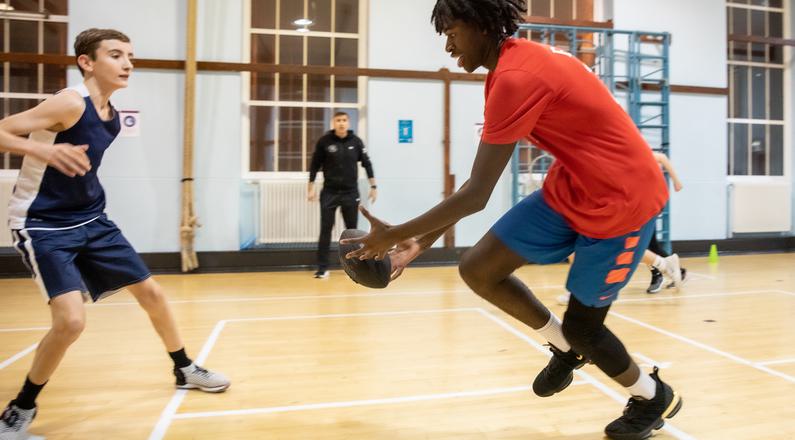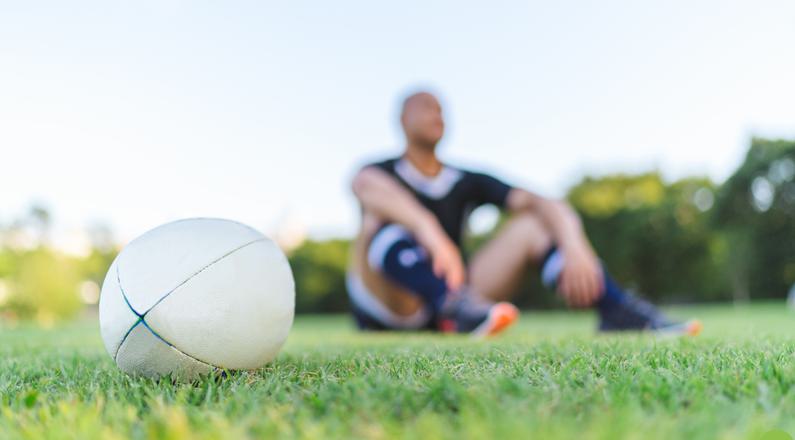The Young Athlete's Perspective: Learning to Play the Game
by Dr. Graham Turner
The emergence of self-presentational behaviour (impression management) is particularly relevant to talent development in sport where the young person’s ability to develop and maintain positive developmental relationships with the coach is critical to their learning. Self-presentation is defined as:
‘the process by which an individual attempts to control the impressions others form of them’
and this behaviour is predicated on the desire to achieve interpersonal goals. This article draws upon the experience of athletes Steve, Laura, Rowan, Josh, Eboni and George from the book: The Young Athlete's Perspective: Talent Development Stories: What They Want and Need, which features stories told by young athletes about their talent development experiences in sport and reveals how and why self-presentation comes into play.

Self-presentation relates to the phenomenon where people learn to adjust their behaviour to conform to the expectations and values of important others in the group within which they seek to belong. This behaviour is typically employed by a ‘low strength’ individual (the athlete) to impress a ‘high strength other’ (the coach) and is designed to generate a particular image to appeal to a specific audience. Self-presentation therefore represents an active attempt to selectively project personal qualities and abilities with the intention to maximise the potential for creating a positive impression.
In the talent development environment young athletes not only learn to look for when they are being watched (watching the watchers) but also learn to make judgements about the relative importance of what is being watched, by whom and when. Steve’s description of his experience during a trial demonstrates how in a specific sporting situation the young person can become acutely aware of the attention and focus of the observer.
Interviewer: “Did you get an impression they were looking there?”
Steve: “Yes, I got that. ……………..The people that actually made the decision weren’t (looking) in the warmup (and) skills bit, they were just watching the game at the end.”
Consequently, the emergence of self-presentational behaviour presents as a distinct feature of talent development in sport where continual evaluation is a critical component of the process.
Rowan: “Coaches look for a hard trainer, because a hard trainer looks like a player that is committed to the sport and wants to learn, so I make sure that even in the warmup I am always at the front.”
Examination of young people’s use of ingratiation, used to indicate likeability and self-promotion, used to indicate competence has found that younger children (six to eleven years) orientate strategic behaviour towards likeability to influence positive social evaluation. However, at around the age of ten years old, the research shows that children begin to demonstrate increasing levels of interpersonal motivation. Self-presentational behaviour then starts to change as young people begin to recognise that self-promotional tactics can have a more instrumental function in relation to the judgement of their ability.
Rowan: “When I see my opposition scrum half, I watch what he is doing. If he doesn’t have a kick that’s what I try to notice, then I use my kick to put him in positions where he has to kick. So I try and make him look bad compared to me.”

Making and Sustaining an Impression
Entry into a talent development programme is premised upon the acceptance of having been judged. Participation then exposes the young athlete to a unique set of social and emotional challenges and research that has looked at the experience of ‘gifted and talented’ individuals confirms that success brings its own set of problems which result from and then impact upon subsequent development. Progression is underpinned by interaction that is motivated by a form of cooperation that is driven by the agenda of the coach and enabled by the co-operation of the athlete who,
‘must keep up their good reputation in order to keep being chosen to participate.’
Young athletes reveal that the way this dynamic can play out has great significance for their health and wellbeing,
Interviewer: “So how aware of your injury situation was your coach?”
Steve: “Yes he knew, he said to me before if it hurts don’t do it but don’t use it as an excuse not to do it and from that I took it well I’m going to have to do it then.”
Interviewer: “So were you feeling it in the session?”
Steve: “Yes, but I just kept running because of what he said. I probably made it worse.”
Interviewer: “So from your perspective then, why is that?”
Steve: “It is because if you want to impress the coach, then you do not want to say, oh I’m injured can I drop out, you just want to keep playing because you don’t want to look silly not doing it.”
And in team sports the athlete may find it even harder to develop the personal relationship they feel they want and need,
George: “You’re pretty much talking to the guys that are gonna decide whether you’re gonna become a professional or not. So, you don’t want to say anything that’s gonna put you in a bad spot with them really.”
Interviewer: “So that means that they don’t find out how people really feel about things?”
George: “No, no, probably not, no. I mean we never, ever really speak, I’ve never had an experience where they’ve spoke to players like if maybe if lads aren’t training that well or lads just kind of like don’t look their normal selves. There’s never been a situation where somebody’s pulled them out and said, “You don’t look yourself today.” It’s normally just it all gets left to build up.”
Self-promotion requires the individual to recognise how to impress. This ability relies upon the development of self-awareness and young people with greater context specific experience develop a heightened sensitivity to factors connected to preserving reputation and public image. Examination of young people’s capacity to understand the self-presentational behaviour of others demonstrates that differential levels of success can be attributed to time spent and experience in specific settings. Here Josh explains,
Josh: “It’s quite interesting seeing the others, especially the ones that have been at it a lot longer than me. Because they, when they conduct themselves around the coaches, they’re completely different to what I’m like. They’re all nicey, nice to them, whereas I don’t really speak to them. I just get on with it.”
Interviewer: So are they impression managing?
Josh: “Yeah. I think at the end of the day, I think that’s really what it’s about. It’s how you look, how you conduct yourself……………………… They gotta like you. It’s like any sport, if you haven’t got the right attitude, they won’t pick you.”
Studies on self-presentation have found that this behaviour is not enacted in the same way for boys as it is for girls and that girls may be less likely to orientate towards self-promotion and more likely to employ less overt styles of interaction to find common ground.
Laura: “Coaches can be quite difficult people, but I think we have sorted it out now because I was talking to her the other day, and I think the problem is that she struggles to talk to teenagers as well as younger children, but she can be nice.”
“Quite a few of us have moved into her group now so she is going to have to learn.”
In the talent development environment, the behaviour of the coach teaches the athlete that their behaviour is under constant scrutiny, and this can result in an inconsistency between what the coach is looking for and what the athlete believes they are really looking for,
George: “They want to find who is the best at that time and they put them in a team, they are trying to develop a team which is going to win for them, they say they are trying to develop players but there is not a lot of emphasis on trying to develop players.”
Self-presentation is a behaviour that is integral to the psychosocial development of the young athlete. The impression that a coach forms of an athlete guides their perception, interpretation, and expectation, whilst also shaping their affective, cognitive and behavioural response and interaction.
So, when the objectives of the coach and athlete do not align, participation for the young person may feel more like compulsion. Genuine talent development relationships are best served by authentic communication where coach and athlete share perspectives, establish trust, and work together to overcome problems and reach common goals.
Eboni: “I spoke to my coach recently and said I don’t really the see the point in doing it anymore if I’m not going to get any further so then we had a talk and she said I need to improve my fitness, which I did, and to get to the next step I needed to go through Regional for another half a year, so I could get moved up to the next level…………………………So now she has moved me up again so I am half in Regional and half in the Academy.”
Steve: “Yes, they are much better, much better coaches, yes.”
Interviewer: “OK, so what makes you say that then?”
Steve: “They have one on one conversations with you about things, like what they want you to do next game or how the last game went, and they seem like they care a bit more and they are actually happy that we have done well.”

Find Out More
If the examples referred to here, have encouraged you to reflect on the relationships you have with your athletes you can learn more about this topic in the book: The Young Athlete's Perspective: Talent Development Stories
View on AmazonThe book will provides you with valuable insights into key topics and issues, such as:
- How to support young athletes to progress in the sport that is right for them.
- How a positive talent development experience relies upon personalised and holistic athlete development.
- How to guide the young athlete through competing physical demands and psychological challenges.
- Why optimal athlete and coach collaboration relies upon a genuine relationship and authentic communication.
- How autonomy, connectedness and a sense of competence are critical to a young athlete’s motivation.
- How to teach the young athlete to become the best learner.
The young athlete stories in this book are designed to stand alone and speak for themselves. They provide the young athlete’s perspective on what they need and what they want in their own words. I invite you to listen.
Contributor:

DR. GRAHAM TURNER
Graham works for the Australian Institute of Sport (AIS) as an athlete development systems leader, supporting sports to establish world’s best High Performance Pathways that identify, develop, support and progress talented athletes to achieve medal winning performances. His career in athlete development and talent pathways began in professional football at Wolverhampton Wanderers (UK). His subsequent experience includes research, design & implementation of National Strategy for Talent Development, (PE & Sport Strategy for Young People UK); design, delivery & evaluation of Coach Education, (Leeds Beckett University), Founder Member & Director on the Inaugural Board of the UK Strength & Conditioning Association; Coach & Athlete Development Consultant (Skill & Behaviour) for the Northern Territory Institute of Sport (AU) and National Elite Coaching Manager for Gymnastics Australia. Graham holds a PhD in Talent Development in Sport
References
Banerjee, R., & Yuill, N. (1999). Children's explanations for self-presentational behaviour. European Journal of Social Psychology, 29(1), 105–111. https://doi.org/10.1002/(SICI)1099-0992(199902)29:1<105::AID-EJSP910>3.0.CO;2-K
Engelmann, J.M. Herrmann, E. & Tomasello, M. (2012) Five-year olds but not chimpanzees, attempt to manage their reputations. PLoS ONE, 7 (10), 1-7
Goffman, E. (1990) The presentation of self in everyday life. London: Penguin
Huang, C.Y. & Lee, C. L. (2014) Influences of agents with a self-reputation awareness component in an evolutionary spatial IPD game. PLoS ONE, 9 (6), 1-13
Leary, M. R., & Kowalski, R. M. (1990). Impression management: A literature review and two-component model. Psychological Bulletin, 107(1), 34–47. https://doi.org/10.1037/0033-2...
Levy, J.L. and Plucker, J. (2003) Theory and Practice: Assessing the psychological presentation of gifted and talented clients: a multicultural perspective. Counselling Psychology Quarterly 16(3):229-247 DOI:10.1080/09515070310001610100
Mrug, S., Hoza, B., Pelham, W. E., Gnagy, E. M., & Greiner, A. R. (2007). Behavior and Peer Status in Children With ADHD: Continuity and Change. Journal of Attention Disorders, 10(4), 359-371. https://doi.org/10.1177/108705...
Payne, S. M. (2011) Impression Management & Self-Presentation in Sport: Measurement, Process & Consequences. Ph.D. thesis, Aberystwyth University
Carron, A. V., Burke, S. M., & Prapavessis, H. (2004). Self-Presentation and Group Influence. Journal of Applied Sport Psychology, 16(1), 41–58. https://doi.org/10.1080/104132...
Turner, G. (2016) ‘Talent’ Mentalities: Young People’s Experience of Being in a Sports Talent Development Programme. PhD. Thesis, Liverpool John Moore’s University
Turner, G (2023) The Young Athlete's Perspective: Talent Development Stories: What They Want and Need : Turner, Graham, Coomer, John, Sainsbury, Jonathan: Amazon.com.au: Books
Watling, D. & Banerjee, R. (2007) Children's Differentiation Between Ingratiation and Self‐Promotion. Psychology, Social Development 1-37
Comments
Related Pages


